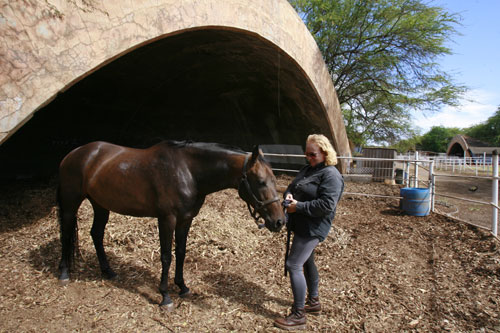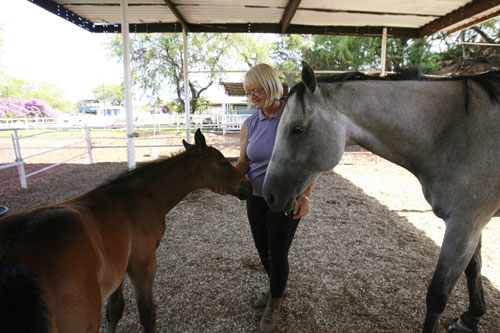Development plans jeopardize future of equestrian group

Nancy Lyons and her thoroughbred Fing stood by the corralled revetment Thursday where she boards her three horses at Barbers Point Riding Club in Kalaeloa. The club has been given notice by the Navy that they will have to move out by the end of June 2011, which will displace its 50 horses and 40 member families.


Serena Thomas rode at Barbers Point Riding Club in Kalaeloa on Thursday. Thomas, who joined when she was 3 years old, grew up riding horses at the club.

Holly Barker spent time Thursday with her mare's nearly 2-month-old foal at Barbers Point Riding Club. Barker is unsure where she will keep her horses if the club is shut down by the Navy after June 2011, when the club's extended lease ends.




Barbers Point Riding Club is 30 acres of bucolic, equestrian heaven on crowded Oahu. The stables have been on the Ewa Plain since the 1950s, and 50 horses and the 40 families that own them call it home.
It also has some of the most unusual "barns" to be found: circa-1942 concrete dome revetments that once housed a beast of a different sort—F-4F Wildcat fighter planes.
The future of both the riding club and the historic revetments are in question as development plans start to overtake the old Marine Corps Air Station Ewa, the target of some of the first attacks by the Japanese on Dec. 7, 1941.
The 1.5 million-square-foot Ka Makana Alii shopping center is planned a mile to the north. The 1,100-acre Ocean Pointe subdivision is to the southeast.
Parts of a 97-acre state Department of Hawaiian Home Lands parcel immediately to the west of the riding club have been staked and surveyed. DHHL says it’s for a possible future city rail transit base yard.
The Navy conveyed 499 acres of land to the north, much of it from the air station, also known as Ewa Field, to a Texas-based developer, the Hunt Cos.
Don't miss out on what's happening!
Stay in touch with breaking news, as it happens, conveniently in your email inbox. It's FREE!
Those development plans have the riding club feeling like it’s being squeezed in the middle.
The Navy, which still owns the riding club land, in April notified the nonprofit club it had 90 days to move out. Horse owners appealed, and the Navy agreed to extend the club’s lease through June 2011.
"When we first got the message in April, we were in shock," said Nancy Lyons, who brought three horses from Montana eight years ago and keeps them at the riding club. "You have these 1,200-pound creatures that are part of your family. Where are you going to put them? It’s not like a dog."
The club said it appreciates the Navy’s support of the program to this point, and it is hoping it can make arrangements to stay. Meanwhile, some members are looking at what they say are less ideal and more costly boarding options elsewhere.
The club, which operates rent-free, said it is willing to pay the Navy to stay. It also wrote a letter to the Army asking whether its Morale, Welfare and Recreation program could oversee the stables. A smaller stable that is half the size and has a lengthy waiting list is run for military families at Wheeler Army Airfield.
"As far as supporting the military, there really is a quality-of-life need here," Lyons said.
Since Barbers Point Naval Air Station was closed in 1999, the Navy has been turning over or leasing the property to government and private entities.
The military stables have hung on as an out-of-sight anachronism, benefiting people who board their horses there with affordable rates and wide-open spaces. The facility is tucked away behind Barbers Point Golf Course, a serene world apart from nearby urban sprawl.
Sixty-foot kiawe trees provide shade and roosters crow at the stables, a mix of close-cropped grass, two riding arenas and former World War II aircraft revetments.
The Navy said in an e-mail it "continues its efforts to be fiscally responsible and compliant with mandates to divest properties not required to support the Navy’s mission, including many of our remaining properties associated with the former Naval Air Station Barbers Point."
"It has been determined that the Navy does not have a requirement for the property currently utilized by the Barbers Point Riding Club, and will begin the process to dispose of the property once the site is vacated."
If there are no federal agencies interested in the land, the government will offer it to DHHL, the Navy said. If DHHL is not interested, the land and 32 revetments will be made available for public benefit conveyance, negotiated sale and public sale at fair market value.
DHHL Director Kaulana Park said Thursday the agency had not been approached by the Navy about the land.
The Navy previously conveyed 97 adjoining acres and about 45 of the half-dome aircraft revetments to DHHL. Park said the agency is pursuing two solar farms on other land it has in what is now known as Kalaeloa, and it is looking at the 97 acres "as a potential base yard for the (city) rail project, if and when it ever comes down."
Asked what would happen to the revetments on the property, Park said: "That I don’t know. It’s still in the assessment stages right now whether or not that goes through. A, the project has to go through, and B, I have to talk about how they plan to clear that (the revetments) off that parcel. So it still needs to be assessed."
A 1997 cultural resources study of Barbers Point conducted for the Navy stated that 75 of the half-dome revetments were potentially eligible for listing on the National Register of Historic Places, and that they should be part of a proposed Ewa Field historic district.
Ewa Beach historian John Bond said part of the weedy Ewa Field should be preserved because of its World War II significance.
"It’s just a shame," he said of the neglect. "It should become some type of national park in my opinion."
The clamshell revetments were featured in the 1970 film "Tora! Tora! Tora!" and Bond said an Ewa Field hangar was blown up in the flick.
The Navy last week said it is working with several groups, including the Historic Hawaii Foundation, "on establishing an appropriate preservation approach" for Ewa Field.
The Pacific War Memorial Association has received donations "to conduct a survey that will determine the amount of land needed for this cause, and … a coordination meeting will be held soon," the Navy said.
The future of the Barbers Point Riding Club also remains to be determined.
The Navy said the stables were built in the 1950s. In the 1960s, the stables hosted the first professional rodeo held in the isles, club members said. The riding club itself was established in 1985.
The 32 revetments on the property, originally designed to shield aircraft from bomb blasts, now provide shade and stalls for horses.
Erin Fernandes took her first riding lessons at the stables in 1972 at age 12. She has two horses there now.
"It’s like family there," she said. "That’s my life. I’ve been there forever."
There were haunted hayrides for Halloween in the 1990s, and people still call and ask about them, she said.
The early history is fuzzy, but Fernandes and others say a concessionaire ran the stables for the Navy before the riding club took over. The military-only stables over time gave way to a mix of military and civilian users.
The Navy said there are now 27 Defense Department riding club members, of whom five are Navy. Lyons, the club’s treasurer, said about half of the 40-family membership is civilian.
The club does not receive any federal money. It doesn’t pay rent to the Navy, but it does pay for its water and electricity, said Lyons, whose husband retired as an Army sergeant major.
Club members said they pay about $95 a month per horse at Barbers Point, compared with up to $250 elsewhere.
Lyons remembers coming from Montana eight years ago, seeing the revetments, and thinking, "This is really a weird place."
But she has since come to think of the stables as paradise.
"It’s still virtually pristine and quiet," Lyons said. "The horses have way more space compared to other boarding places on the island."




